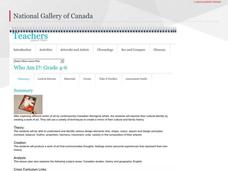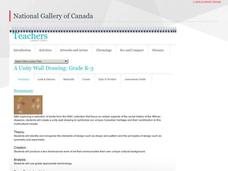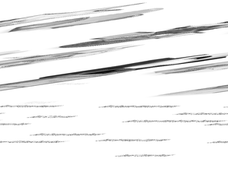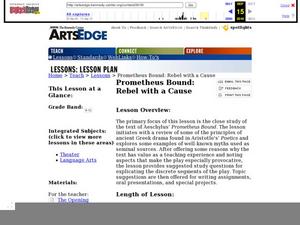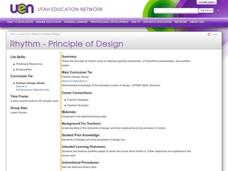National Gallery of Canada
Who Am I?
Connect design elements and principles to identity a culture with a discussion and related art activity. After analyzing artwork in relation to design, class members talk about personal and cultural identity. Using items that represent...
National Gallery of Canada
The Body Tells Its Story
Incorporate sculpture into your art curriculum. To start, pupils discuss the artistic process and topics of marginalization. With the discussion in mind, individuals select images to inspire sculptures of people that they will present to...
National Gallery of Canada
One Look Is Worth A Thousand Words
Facial expressions can communicate complex emotions. Examine expressions in several hyperrealistic works of art before beginning a project. Learners will create their own clay faces that show an emotion using either photos or their own...
National Gallery of Canada
Panoramic Landscapes
Combine landscape with collage to create unique art pieces. Class members examine works of art before creating their own pieces with photos of a special place. Learners create a panoramic image and add in figures.
National Gallery of Canada
Social Realism
Examine social strife in art. Class members first observe some pieces, and then find an image to inspire their own art. They outline the picture, analyze the composition, make alterations, and color their work.
National Gallery of Canada
Build a City of the Future!
Tap into your pupils' imagination by asking them to design futuristic, ideal cities. They must discuss and take scale and size into account, looking at some model pieces of art for inspiration and analysis. The final product for each...
National Gallery of Canada
A Unity Wall Drawing
Build class community with an art project. Learners first examine and discuss works of art. They then contribute to a class mural by tracing their hands and decorating them in relation to their own cultures. The final mural incorporates...
Curated OER
Abstract Planes in Paper Sculpture
High schoolers create maquettes of abstract sculptures utilizing the elements of art; line, shape, value, color, space and texture and the principles of design; balance, emphasis, contrast, rhythm and movement, pattern and unity. These...
Curated OER
Information Problem Solving
Middle schoolers locate the specific elements of text and illustrations that communicate setting, characterization, and plot in order to evaluate how the text and illustrations work together to communicate effectively.
National Gallery of Canada
Tantalizing Tessellations!
Examine repeating and intricate patterns with a study of M.C. Escher and a related art activity. Pupils view and discuss the artwork before creating their own tessellating patterns. Step-by-step instructions for creating a template are...
Curated OER
Prometheus Bound: Rebel with a Cause
If you are teaching Aeschylus' Prometheus Bound, you can't afford to miss this source. An extensive list of ideas outlines numerous discussion topics, writing prompts, comprehension questions, oral presentations, and projects. Have class...
National Gallery of Canada
Make a Parfleche
Examine American Indian art and culture by observing contemporary art and creating original pieces. Class members discuss artwork included in the plan and use these images to help inspire their own work, which should represent their...
Curated OER
Humourous Head Planter Spike: Ceramics Lesson
What a great activity. Kids create humorous ceramic character (heads) spikes to enliven a planter. Modern art is full of expressive and exaggerated forms and your class gets to create them out of clay. This would be a lovely activity to...
Curated OER
Garbage or Art?
The three R's are, reduce, reuse, and recycle. Third graders use recycled materials to design and create an environmentally themed piece of art. They discuss and examine major art works that were created using recycled materials, then...
Curated OER
Paper Maché Mancala Game Boards
Seventh graders create three dimensional works of art from two dimensional plans, develop skills in papier-mach?? technique, utilize elements and principles of design to create 3-D form, and develop math/strategy skills in playing the...
Curated OER
Tony Cragg-Evidence
Students demonstrate an understanding of basic elements and principles of art making such as unity, variety, movement, and meaning found in daily experiences. They also describe the meaning of students¿ own artwork in a written statement.
Curated OER
Give It All You’ve Got Heroes and Visual Art
Sure, your young artists probably know Van Gogh and Picasso, but are they equally as familiar with Frida Kahlo and Andy Warhol? Small groups examine the work of famous artists. Then, they create their own hero portraits in Cubist style...
Curated OER
Line and Design (Advanced)
As part of an exploration of line and design, students complete a variety of activities which include discussing a list of vocabulary terms, and learning about principles of design.
Curated OER
The Art of Illustrator Eric Carle
First graders use two-dimensional and three-dimensional media and techniques to communicate ideas, experiences, and stories in works of art. They use media and tools in a safe and responsible manner
Curated OER
VISUAL ARTS
Young scholars learn the historical context of mask-making explore the elements of the art form.
Curated OER
Rhythm - Principle of Design
Students demonstrate knowledge of the principles of design. They produce portfolio pages to show they know what rhythm is and demonstrate the elements of design and their relationship to the principle of rhythm. They explore the world of...
Curated OER
Communicating Feelings through
Sixth graders use subjects, themes, and symbols to communicate meaning in their own works of art. They describe the origins of specific images and ideas and explain why they are of value in their artwork and in the work of others.
Curated OER
Politics and Religion in 17th Century Dutch Art
Seventh graders examine different pieces of Dutch Art. They identify its social and political meanings by using cultural and historical information. They examine maps of the time period as well.
Curated OER
SENSORY ELEMENTS
Students describe the sensory elements of musical selections (i.e., tempos, dynamics, and articulations). They write an essay evaluating Saint-Saens' effectiveness in using sensory elements in both selections. They describe the...
Other popular searches
- Art Elements and Principles
- Art Elements & Principles
- Art Elements Principles
- Principles and Elements of Art


